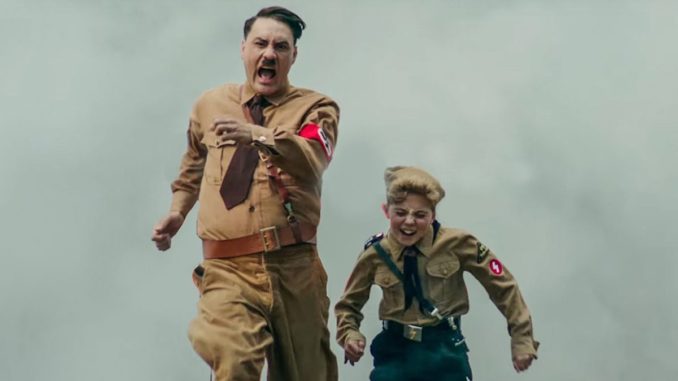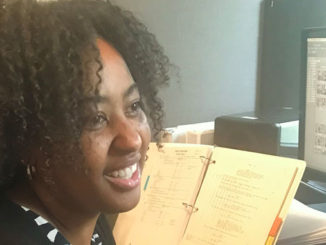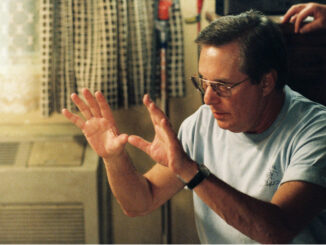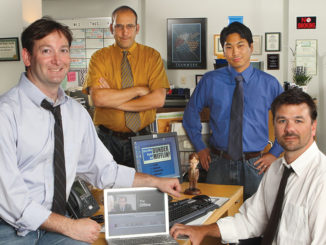
“Jojo Rabbit” is the kind of film that can make studio executives nervous.
Director Taika Waititi offers a coming-of-age story with a twist: The 10 year-old title hero (Roman Davis Griffin), who is struggling to find his way in Nazi Germany, has an imaginary friend and confidante in a goofball version of Adolf Hitler (played by Waititi himself).
The film is meant as a takedown of fascism and hateful politics, but it reportedly prompted some anxieties among Disney executives, who now control the levers at distributor Fox Searchlight.
Vice called the film – which also stars Scarlett Johansson (as Jojo’s mom Rose), Sam Rockwell (as a loopy but kind-hearted Nazi captain), Rebel Wilson (as a Hitler Youth overseer) and Thomasin McKenzie (as the young Jewish girl Rose is hiding in her attic) – “bonkers.”
CineMontage asked Guild member Tom Eagles, who edited the picture, for his thoughts on the controversial release, which hits theaters Friday:
How did you start working with Taika?
Eagles: I first met Taika Waititi in his starving artist, couch-surfer phase. I woke up one day and literally found him on my couch. My wife Dannelle was designing hair and make-up on “Boy” and she introduced us. We hit it off and Taika asked me to cut some trailers for the film.
From there I went on to cut on “What We Do in the Shadows” and “Hunt for the Wilderpeople” and a number of other projects. Taika was already talking about “Jojo Rabbit” even before “Shadows” and I was astounded and intrigued by the audacity of it.
And then you got the script.
Yes. Once I read it I was totally drawn in to the childlike and ultimately innocent take on one of the most horrific chapters in history. Taika had found a fresh way to retell this story to a new generation, to warn young people about the dangers of hate. The script was tight and as with all of his scripts I had a few laugh-out-loud moments just sitting reading it.

What was making the film like?
I was cutting in Prague from the first day of principal photography, though I steer clear of the set itself in order not to be unduly influenced by anything outside the frame.
After wrap Taika took a break for a couple of weeks while I put the assembly together and relocated the edit to LA. This is where the wonderful Daniel Nussbaum came on as First AE, taking over from the great Prague team of Martin Hubcek and Amanda Ekelund. We eventually got Shelby Hall as 2nd AE and Morgan Kern as apprentice.
Taika encouraged me to put forward the tightest assembly I could in the time I had, and not to be afraid of cutting scenes. I did that, but I still erred on the side of caution, as there were things that I just wanted him to see and judge for himself. He came back to it refreshed and was able to offer perspective on all those things.
This must have been a tricky edit. You’re sometimes mining Adolf Hitler and World War II for laughs.
Tone was a tightrope walk from the start. Transitioning us from comedy in the first act to true emotion and pathos by the end.
Humor is key to Taika’s filmmaking and towards re-engaging people with this subject matter. Humor opens a door and loosens people up, so they can see things from a new perspective.
We had to make people feel comfortable enough to laugh, without beveling off any of the hard edges or flinching from the subject matter. The first 10 minutes were crucial.
Our secret weapon turned out to be Taika himself, as Jojo’s idiotic imaginary version of Adolf Hitler, who appears to him as a result of a number of factors – an absent father, an ideology of hate all around him, Jojo’s insecurity and need to fit in. Taika had scripted a number of versions of this scene, with and without Hitler.
When we put him in that opening scene it really struck a keynote for the tone of the movie. It also allowed us to establish much more effectively Jojo’s vulnerability and self-doubt because he had someone to express that to.
There are some wild anachronisms. For instance, you use The Beatles’ German version of “I Want to Hold Your Hand” for the opening credits.
The opening title sequence was important. Taika had written this totally gonzo kind of allegory of Beatlemania – Hitler was some kind of demigod in that world and a lot of the populace were totally smitten with him. It was important to put Jojo’s adulation in this context. I had a lot of fun syncing the archive material to the song, making people look like they were singing along or playing the music. This was some of the hardest footage to find and clear, but we really fought hard for it.
Equally it was important to establish the danger lurking beneath the surface of Jojo’s world, and the first time we really see that is when Jojo and Rosie (Scarlett Johansson) come across the bodies of some resistance fighters hanging in the town square. It’s a jarring moment, and some folks shied away from that, but I felt it was important to establish that darker element early on.
The tone does change as the picture moves along.
We reined in some of the comedy in the second half of the movie; it’s like a slow-motion rug pull, delivering you from laughs to tears by the end. But we elected not to depart from it entirely. We wanted the film to come full circle.
We certainly could have cut a straight comedy packed with gags. While the script was always our template, Taika is very playful with the actors and collects a variety of performances and riffs with them.
It’s a large cast of characters. What was that like, cutting all those personalities?
We had a whole range of performers, from very serious actor’s actors like Scarlett and Thomasin who would really dig in to a scene, to comedians like Stephen and Rebel who would improv a lot with Taika, to Sam, who’s all of the above. And then you had a couple of child actors who would give you these pure nuggets of authenticity. These would become my pivot points and I would often build the scene around them.
The whole film is told from Jojo’s POV, so it’s all told through this weird filter of a 10 year-old’s imagination as warped by fascist propaganda. The exceptions were the scenes between Elsa and Rosie. Here you see the real state of things and what a show Rosie puts on for Jojo.
We had wonderful dailies where both characters break down into tears, but in the end we tried to sharpen Elsa’s anger and keep Rosie in a place where she’s just trying to hold it all together. Hopefully we steer clear of sentimentality while still allowing you to feel what they’re feeling.
To go back to the music – how did you work all those different musical styles into the cut?
I always do a lot of prep with music, it’s just a part of my process – even if it’s not stuff that I’m going to use, it can be helpful to me as a way in to a character or a period. This time Taika already had a couple of the needle drops ahead of time – e.g., the Beatles and Bowie – so it was just a case of finding a couple more and then turning my attention to source cues and temp score.
I was looking for music that helped show the world through Jojo’s perspective and in the end I found a whole lot of Carl Orff pieces for small children’s ensembles. It was martial, but kind of innocent and wonky – like kids playing at war, lots of flutes and percussion. I knew Taika would be in because he’s a massive Badlands fan. I also used a lot of choral works, particularly towards the end where the emotional stakes get a little higher – a lot of Vienna Boys Choir!
Then [composer] Michael Giacchino came on board and brought a whole other layer of emotion and heart to the score. It was a joy working with him, he just sits down and writes from beginning to end and follows his heart and his ear. Then we would go out to his studio and he and Taika would jam ideas. Ultimately he was able to ground it all and give it some soul, creating a cohesive tone for the movie.
What were the biggest challenges in cutting, in terms of structure?
Initially we were concerned that we would need to get out of the room that much of the drama in Jojo and Elsa’s story takes place in. We thought it might get stifling or claustrophobic. The opposite turned out to be true – any time we strayed from that relationship for too long we lost momentum. So we cut back on some of the broader world and really honed in on that relationship.
Taika’s always keen to test the structure; he’s not precious about his scripts. We jammed out about a dozen potential structures for the second act on the walls of the edit suite but in the end we wound up with something pretty close to the original script.
After we had the shape pretty well locked in, we had [consulting editor] Yana Gorskaya come in. Yana’s been working with Taika since the get-go. It’s a great opportunity to get another perspective and see if we’re missing anything. We swapped for a couple of weeks and I filled in for her on “What We do in the Shadows,” but the best time was the week we spent working together because there was someone else to bounce off, another editor who speaks your language so it’s not just me and Taika and producer Carthew Neal in an echo chamber. Likewise Alan Baumgarten [credited for additional editing] also lent his experienced eye over a couple of bridging weeks. I then took their work and folded it back into the whole, always trying to keep the tone and rhythm consistent.
Did you do test screenings?
Yes. That’s really integral to our process, screenings. We screen to friends and family every couple of weeks, then eventually go wider with bigger rooms of two or three hundred people. It’s great getting people’s feedback on what landed for them, anything they didn’t understand, but even before that you can feel if the film’s working or not. Obviously you get laughs and gasps and other responses, but you can also just feel it. If the hair doesn’t stand up in the back of my neck in certain scenes, then I know I’m not doing my job right and I have to go back to the drawing board.
By the end of that process I was getting the right feeling in all the right places and the atmosphere in the room was pretty electric. I can only hope that everyone feels the same way I do when I watch it.





